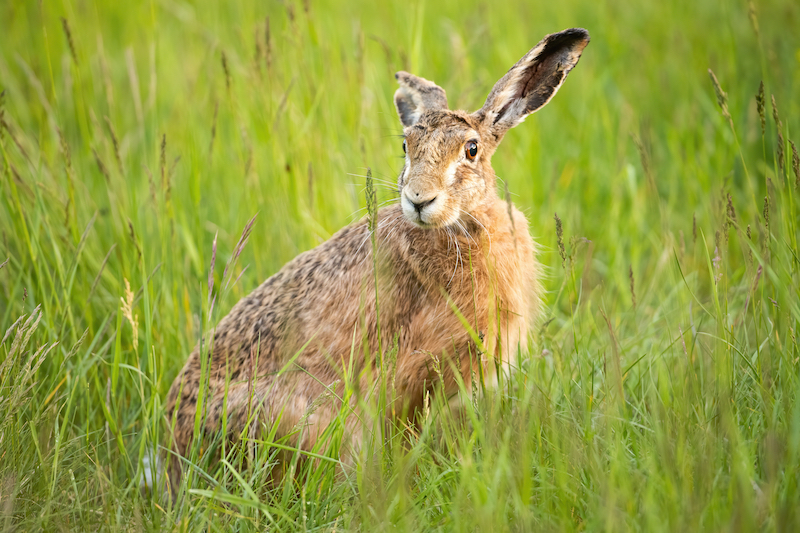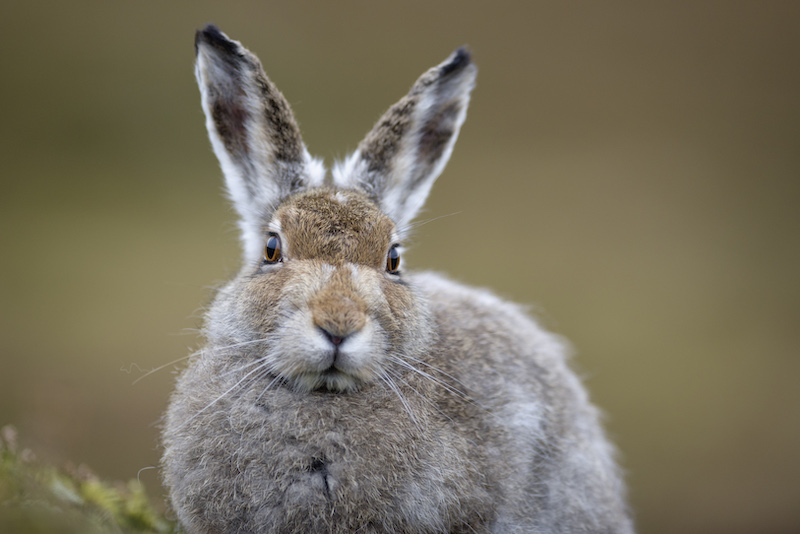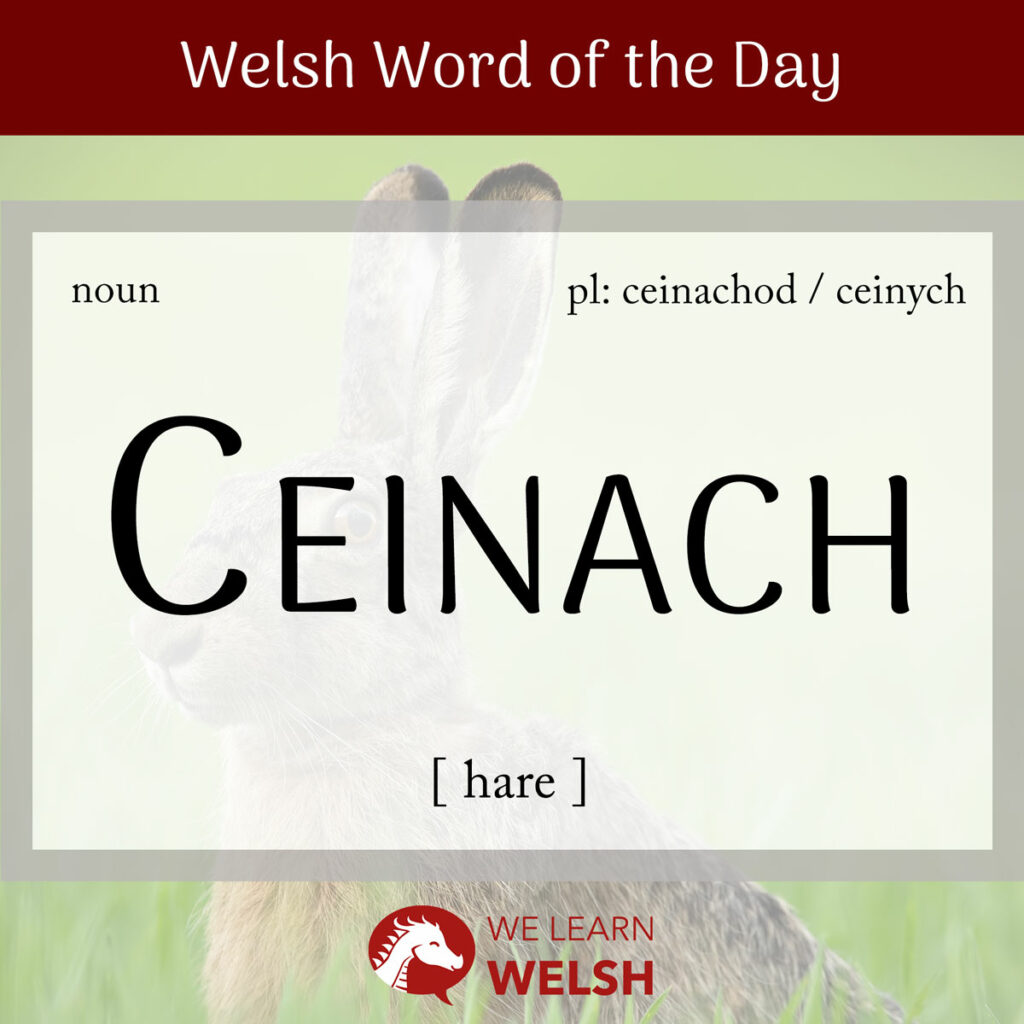Did you know that Welsh has two, very different forms? These are literary and colloquial Welsh – the Welsh you’ll find in poetry and historical documents is very different to the Welsh spoken in even the most formal contexts.
And some Welsh words are these days mostly used only in the former context. One of these is the beautiful ceinach, a poetic term for a hare.
ceinach
hare
You might assume that ceinach is related to the word cwningen (rabbit) – but you’d be wrong! Ceinach is actually the product of combining the Celtic root word *kasni with the suffix –ach, which is often used as a pejorative (e.g. pethau, things, becomes pethach, unimportant things).
It’s hard to know what exactly *kasni meant, but other words which are probably related to it include the Latin cascus (old) and canus (white), and Old Prussian *sasnis (hare). Its closest Welsh relation is can (glowing/bleached white), so the best literal translation of ceinach would be that white one.

The plurals of ceinach are ceinachod and ceinych, both equally valid, and it mutates like this:
Soft mutation
geinach
Nasal mutation
ngheinach
Aspirate mutation
cheinach
Since ceinach is a feminine noun, it needs to mutate after the definite article, becoming y geinach (the hare).
Of course, because it’s a literary word, mostly archaic in everyday speech, there is a more common equivalent that is used colloquially.
This is ysgyfarnog (often shortened to sgwarnog) – so save ceinach (and the other literary term cath eithin, gorse cat) for your nature poetry and use ysgyfarnog when having a conversation. A buck hare is a bwch ysgyfarnog and a doe hare is simply an ysgyfarnog fenyw (female hare).
ysgyfarnog
hare
There is also a fair amount of regional slang for hare, like cochen which you may hear bandied around in South Wales. I’d love to know if cochen is linguistically related to ceinach itself!
Less kindly, hares are sometimes also called pryfed or pryfed mawr. Mawr means big, and pryf means insect, but is used frequently in Welsh for any kind of pest. It makes sense, then, that pryfeta (to hunt vermin) can also be used to describe hunting hares (hela ysgyfarnogod). This hunting might be done with a ceinachgi (hare-hound).
Note that in the example above, ceinych doesn’t mutate even though it’s after the definite article. Plural nouns don’t mutate after y in Welsh, not even plural forms of feminine nouns.
But talk of hunting hares does persist throughout Welsh popular culture, and hare stew (cawl) would have been considered a very tasty meal in medieval Wales. They’re notoriously tricky to catch though – the Welsh folk song Bonheddwr Mawr o’r Bala (A Big Gentleman from Bala) laments that the bonheddwr spent his whole day of hunting heb unwaith godi pry (without once raising a hare).
And if you thought you’d heard enough words for hare, there are actually completely different words used for a young or adolescent hare. One of these is lefran (leveret).
The other is glastorch, which can also refer to a specific species, the mountain hare. The glas in glastorch is the same glas that we hear in modern Welsh to mean blue, but archaically, it could also mean grey or green. In this case, it refers to the grey of a hare’s coat, similar to the etymology of our word of the day ceinach.
Trawsnewidiodd y ddewines yn geinach.
The sorceress transformed into a hare.
Compared to other cnofilod (rodents), ceinych have a rather romantic history. They occupy a big place in Welsh and English folklore – associated with magic and often popularly believed to be ghosts, trickster spirits, or witches.
In both England and Wales, ceinych are associated with madness. Whilst in England you might call someone as mad as a March hare, the Welsh will agree that they are cyn wyllted ag ysgyfarnogod ym Mawrth (just as mad as hares in March).

One key place where ceinych turn up in Welsh culture is in the story of the gwrach (witch) Ceridwen. Ceridwen hired a young boy to tend to a potion she was making, intended to endow her son with awen (wisdom / poetic inspiration).
When the serving boy licked some of the potion, she chased him, with each of them turning into various animals during the pursuit, including a ceinach and a ceinachgi.
You’ll also hear talk of these lanky creatures in the story of the life of Saint Melangell, an Irish princess who escaped an arranged marriage to become an abbess in Powys in the 700s. She was said to have once protected a ceinach from a pack of ceinachgwn (hare-hounds), and become their patron saint.
According to the legend, all wild anifeiliad in the vicinity of her parish did her bidding, and locals in the area didn’t dare to kill a ceinach as late 1900. Indeed, even today you might hear older people in this part of Wales referring to ceinych as wyn fach Melangell (Melangell’s little lambs).
Santes Melangell sy’n gwarchod y ceinych.
It’s Saint Melangell that protects the hares.
Santes Melangell might have been onto something. Ceinych are disappearing from South Wales due to the area’s diwydiannu (industrialisation) throughout the 20th century – though Gower is a good area to visit if you’d like to catch a glimpse of one. They’re more cyffredin (common) throughout the rural mid and North Wales, but hela (hunting) is still affecting their numbers.
And the beautiful glastorch (mountain hare) is now a protected species. Though there were once plenty of these lovely creatures in Snowdonia, they have since died out and can only be found in Scotland and the North of England.
Maybe this is why ceinach is still my favourite word for hare, despite all the alternatives. In all its literary pomp and glory, it’s a word that conveys a sense of mystery and magic, reminding us of the role that ceinych have played in Celtic culture historically, and the protection we owe them today.

